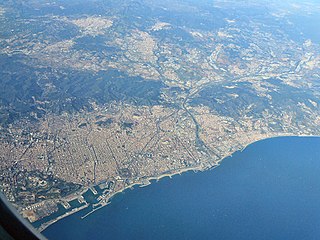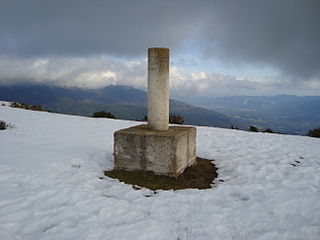Related Research Articles

Baix Llobregat is a comarca (county) on the coast of Catalonia, Spain. Its capital is Sant Feliu de Llobregat.

Barcelona is a province of eastern Spain, in the center of the autonomous community of Catalonia. The province is bordered by the provinces of Tarragona, Lleida, and Girona, and by the Mediterranean Sea. Its area is 7,726 km2 (2,983 sq mi). 5,609,350 people live in the province, of whom about 30% (1,620,343) live within the administrative limits of the city of Barcelona, which itself is contained in the Barcelona metropolitan area.

Alt Camp is a comarca (county) in Catalonia, Spain. It is one of the three comarques into which Camp de Tarragona was divided in the comarcal division of 1936.

The Statistical Institute of Catalonia is the official body responsible for collecting and publishing statistics in the autonomous community of Catalonia, Spain. The institute comes under the Department of the Economy and Finances of the Generalitat de Catalunya.

C-25 or Eix Transversal is a 280 km long primary highway in Catalonia, Spain. It crosses the Catalan Transversal Range mountainous region, connecting the northern end of the Catalan Coastal Depression with the Catalan Central Depression.

The Barcelona–Vallès Line is an unconnected standard gauge railway line linking Barcelona with Sabadell and Terrassa via the Collserola mountain range, in Catalonia, Spain. Its name refers to the Catalan historical region of Vallès, whereby most part of the line runs. Plaça de Catalunya station serves as the Barcelona terminus of the line, where almost all its trains either start or terminate. The line then continues northwards and branches off twice before leaving the city limits. Its main route splits in two in Sant Cugat del Vallès, forming two major branches to Sabadell and Terrassa. It has 40 passenger stations in operation and a total line length of 48.1 kilometres (29.9 mi).

Lleida Pirineus is an important railway station serving the city of Lleida in Catalonia, Spain. It is located between the neighbourhoods of Pardinyes and Rambla de Ferran. The first train services in Lleida date of 1860, but the station wasn't built until 1927, and it did not adopt its current official name until 2003, when it underwent an ambitious reform. As a transport hub connecting the interior of Spain with the Corredor Mediterráneo, it serves both broad gauge and standard gauge trains, operated by both Adif-Renfe and Ferrocarrils de la Generalitat de Catalunya. It is the terminus of several regional railway services centered in Aragon and Catalonia. It's also one of the stations on the Madrid–Barcelona high-speed rail line, and it was its north-eastern terminus until 2008.

Turó de Morou is a mountain of Catalonia, Spain. It has an elevation of 1,303 metres above sea level.

Turó del Samont is a mountain of Catalonia, Spain. It has an elevation of 1,272 metres above sea level.

Sant Jeroni is a mountain of Catalonia, Spain. It has an elevation of 1,236 metres above sea level.
Turó de Bellver is a mountain of Catalonia, Spain. It has an elevation of 1,041 metres above sea level.

Puig Castellar (Balenyà) is a mountain of Catalonia, Spain. It has an elevation of 1,017 metres above sea level.
Punta de la Barrina is a mountain of Catalonia, Spain. It has an elevation of 1,013 metres above sea level.

Turó de Sant Elies is a mountain of Catalonia, Spain. It has an elevation of 1,003 m (3,291 ft) above sea level.
Puig Cornador is a mountain of Catalonia, Spain. It has an elevation of 859 metres above sea level.

Turó de la Creu de Gurb is a mountain of Catalonia, Spain. It has an elevation of 841 metres above sea level.

Turó Gros is a mountain of Catalonia, Spain. It has an elevation of 766 metres above sea level.
Puig Cornador is a mountain of Catalonia, Spain. It has an elevation of 621 metres above sea level.

The 2010 Catalan autonomy protest was a demonstration in central Barcelona on 10 July 2010 against limitations of the autonomy of Catalonia, and particularly against a recent decision of the Spanish Constitutional Court to annul or reinterpret several articles of the 2006 Statute of Autonomy of Catalonia. The number of people taking part in the demonstration was estimated at between 1.1 million and 1.5 million, while Madrid-based newspaper El País estimated the number of demonstrators at 425,000. The mobilisation was described as "unprecedented" by the mayor of Barcelona. The Barcelona daily newspaper El Periódico de Catalunya described it as "without a doubt one of the biggest protest marches that has ever occurred in Catalonia, possibly the biggest". It is thought that the 2012 Catalan independence demonstration involved more people, but this protest brought the dispute to light in the world.

The Catalan Transversal Range is a system of minor mountain ranges at the eastern end of the Pre-Pyrenees, between the Osona and Garrotxa comarques. The existence of the Catalan Transversal Range has made communications in the northern areas of Catalonia difficult in the past, especially between Northeastern Catalonia and Western Catalonia, a problem that has been partly solved with the development of the Eix Transversal.
References
- ↑ "Mapa Topogràfic de Catalunya". Institut Cartogràfic de Catalunya. Retrieved May 22, 2010..